Experimental and Modeling Investigations on the Water Sorption Behaviors of Autoclaved Aerated Concrete
Abstract
:1. Introduction
2. Materials and Methods
3. Results and Discussion
4. Conclusions
Author Contributions
Funding
Institutional Review Board Statement
Informed Consent Statement
Data Availability Statement
Conflicts of Interest
References
- Brunauer, S.; Deming, L.S.; Deming, W.E.; Teller, E. Theory of the van der Waals Adsorption of Gases. J. Am. Chem. Soc. 1940, 62, 1723–1732. [Google Scholar] [CrossRef]
- Sing, K.S.W. Reporting physisorption data for gas/solid systems with special reference to the determination of surface area and porosity. Pure Appl. Chem. 1982, 54, 2201–2218. [Google Scholar] [CrossRef]
- Keller, J.; Staudt, R. Gas Adsorption Equilibria: Experimental Methods and Adsorption Isotherms; Springer: New York, NY, USA, 2005. [Google Scholar] [CrossRef] [Green Version]
- Lowell, S.; Shields, J.E.; Thomas, M.A.; Thommes, M. Characterization of Porous Solids and Powders: Surface Area, Pore Size and Density; Kluwer Academic Publishers: Dordrecht, The Netherlands, 2004. [Google Scholar] [CrossRef]
- Rouquerol, J.; Rouquerol, F.; Sing, K. Absorption by Powders and Porous Solids; Academic Press: Cambridge, MA, USA, 1998. [Google Scholar] [CrossRef]
- Perry, R.H.; Green, D.W. Perry’s Chemical Engineers’ Handbook; McGraw-Hill: New York, NY, USA, 1997; ISBN 0070498415. [Google Scholar]
- Campanale, M.; Deganello, M.; Moro, L. Effect of Moisture Movement on Tested Thermal Conductivity of Moist Aerated Autoclaved Concrete. Transp. Porous Media 2013, 98, 125–146. [Google Scholar] [CrossRef]
- Chen, H.Y.; Chen, C. Equilibrium relative humidity method used to determine the sorption isotherm of autoclaved aerated concrete. Build. Environ. 2014, 81, 427–435. [Google Scholar] [CrossRef]
- Feng, C.; Janssen, H.; Wu, C.; Feng, Y.; Meng, Q. Validating various measures to accelerate the static gravimetric sorption isotherm determination. Build. Environ. 2013, 69, 64–71. [Google Scholar] [CrossRef] [Green Version]
- Giarma, C. Proposal of an empirical relationship for moisture storage function of concrete. Bauphysik 2010, 32, 160–166. [Google Scholar] [CrossRef]
- Gómez, I.; Sala, J.M.; Millán, J.A. Moisture storage properties of multi-slotted light-weight ceramic blocks: Comparison between two manufacturers. J. Build. Phys. 2008, 31, 225–242. [Google Scholar] [CrossRef]
- Kumar, A.; Ketel, S.; Vance, K.; Oey, T.; Neithalath, N.; Sant, G. Water Vapor Sorption in Cementitious Materials—Measurement, Modeling and Interpretation. Transp. Porous Media 2014, 103, 69–98. [Google Scholar] [CrossRef]
- Pavlík, Z.; Medved, I.; Žumár, J.; Pavlíková, M.; Černý, R. Theoretical formulas for approximation of sorption isotherms of chosen building materials. In Proceedings of the 19th International Meeting of Thermophysical Society, Podkylava, Slovak Republic, 8–10 October 2014; pp. 89–96. [Google Scholar]
- Pavlík, Z.; Žumár, J.; Medved, I.; Černý, R. Water vapor adsorption in porous building materials: Experimental measurement and theoretical analysis. Transp. Porous Media 2012, 91, 939–954. [Google Scholar] [CrossRef]
- Wang, Y.; Huang, J.; Wang, D.; Liu, Y.; Zhao, Z.; Liu, A. Experimental study on hygrothermal characteristics of coral sand aggregate concrete and aerated concrete under different humidity and temperature conditions. Constr. Build. Mater. 2020, 230, 117034. [Google Scholar] [CrossRef]
- Stolarska, A.; Garbalińska, H. Assessment of suitability of some chosen functions for describing of sorption isotherms in building materials. Heat Mass Transf. 2017, 53, 1603–1617. [Google Scholar] [CrossRef]
- Drochytka, R.; Zach, J. The study of thermal and moisture behavior of autoclaved cellular concrete. In Materials of 5th International Conference on AAC: Securing a Sustainable Future; University of Technology and Life Sciences Press: Bydgoszcz, Poland, 2011; pp. 201–206. [Google Scholar]
- Koronthayova, O. Moisture storage capacity and microstructure of ceramic brick and autoclaved aerated concrete. Constr. Build. Mater. 2011, 25, 879–885. [Google Scholar] [CrossRef]
- Jerman, M.; Keppert, M.; Výborný, J.; Černý, R. Hygric, thermal and durability properties of autoclaved aerated concrete. Constr. Build. Mater. 2013, 41, 352–359. [Google Scholar] [CrossRef]
- Redlich, O.; Peterson, D.L. A useful adsorption isotherm. J. Phys. Chem. 1959, 63, 1024–1026. [Google Scholar] [CrossRef]
- Paderewski, M.L. Adsorption Processes in Chemical Engineering; WNT: Warszawa, Poland, 1999. (In Polish) [Google Scholar]
- Fergusson, R.R.; Barber, R.M. Derivation and development of Huttig’s multilayer sorption isotherm. Trans. Faraday Soc. 1950, 46, 400–407. [Google Scholar] [CrossRef]
- Hüttig, G.F. Zur Auswertung der adsorptions-isothermen. Chem. Mon. 1948, 78, 177–184. [Google Scholar] [CrossRef]
- Łykow, A.W. Transporterscheinungen in Kapillarporösen Körpern; Academie: Berlin, Germany, 1958. [Google Scholar]
- Marynowicz, A.; Wyrwał, J. Testing the Humidity Properties of Selected Building Materials under Isothermal Conditions; Studia z Zakresu Inżynierii: Warszawa, Poland, 2005; Volume 52. (In Polish) [Google Scholar]
- Chen, Y.; Chen, Z. Transfer function method to calculate moisture absorption and desorption in buildings. Build. Environ. 1998, 33, 201–207. [Google Scholar] [CrossRef]
- Jovanović, D.S. Physical adsorption of gases. Colloid Polym. Sci. 1969, 235, 1214–1225. [Google Scholar] [CrossRef]
- ISO 12571. Hygrothermal Performance of Building Materials and Products—Determination of Hygroscopic Sorption Properties; European Committee for Standardization: Brussels, Belgium, 2013. [Google Scholar]
- ASTM E104-02(2012). Standard Practice for Maintaining Constant Relative Humidity by Means of Aqueous Solutions; ASTM International: West Conshohocken, PA, USA, 2012. [Google Scholar]
- Bochenek, M. Evaluation of Hygro-Thermal Properties Variability in Autoclaved Aerated Concrete of Diverse Density. Ph.D. Thesis, West Pomeranian University of Technology Szczecin, Szczecin, Poland, 2016. (In Polish). [Google Scholar]
- Garbalińska, H.; Bochenek, M.; Malorny, W.; Von Werder, J. Comparative analysis of the dynamic vapor sorption (DVS) technique and the traditional method for sorption isotherms determination—Exemplified at autoclaved aerated concrete samples of four density classes. Cem. Concr. Res. 2017, 91, 97–105. [Google Scholar] [CrossRef]
- Garbalińska, H.; Bochenek, M. Experimentelle Ermittlung der Desorptionsisothermen von Porenbeton unterschiedlicher Dichte mit der Standardmethode SSS und mit der DVS-Technik. Bauphysik 2017, 39, 191–196. [Google Scholar] [CrossRef]
- Greenspan, L. Humidity Fixed Points of Binary Saturated Aqueous Solutions. J. Res. Natl. Bur. Stand. A Phys. Chem. 1977, 81A, 89–96. [Google Scholar] [CrossRef]
- Jiřiĉková, M.; Černý, R.; Rovnaniková, P. Measurement of moisture storage parameters of building materials. Acta Polytech. 2003, 43, 39–43. [Google Scholar] [CrossRef]
- Soleimanifard, S.; Hamdami, N. Modelling of the sorption isotherms and determination of the isosteric heat of split pistachios, pistachio kernels and shells. Czech J. Food Sci. 2018, 36, 268–275. [Google Scholar] [CrossRef]
- Mutluab, C.; Koça, A.; Erbaş, M. Some physical properties and adsorption isotherms of vacuum-dried honey powder with different carrier materials. LWT 2020, 134, 110166. [Google Scholar] [CrossRef]
- Saleha, R.; Karim, N.A.; Hensel, O.; Sturm, B. Mathematical modelling of adsorption isotherms of Malaysian variety of purple flesh sweet potato at different temperatures. Therm. Sci. Eng. Prog. 2018, 7, 326–330. [Google Scholar] [CrossRef]
- Peleg, M. Assessment of a semi-empirical four parameter general model for sigmoid moisture sorption isotherms. J. Food Process. Eng. 1993, 16, 21–37. [Google Scholar] [CrossRef]
- Caurie, M. A new model equation for predicting safe storage moisture levels for optimum stability of dehydrated foods. J. Food Technol. 1970, 5, 301–307. [Google Scholar] [CrossRef]
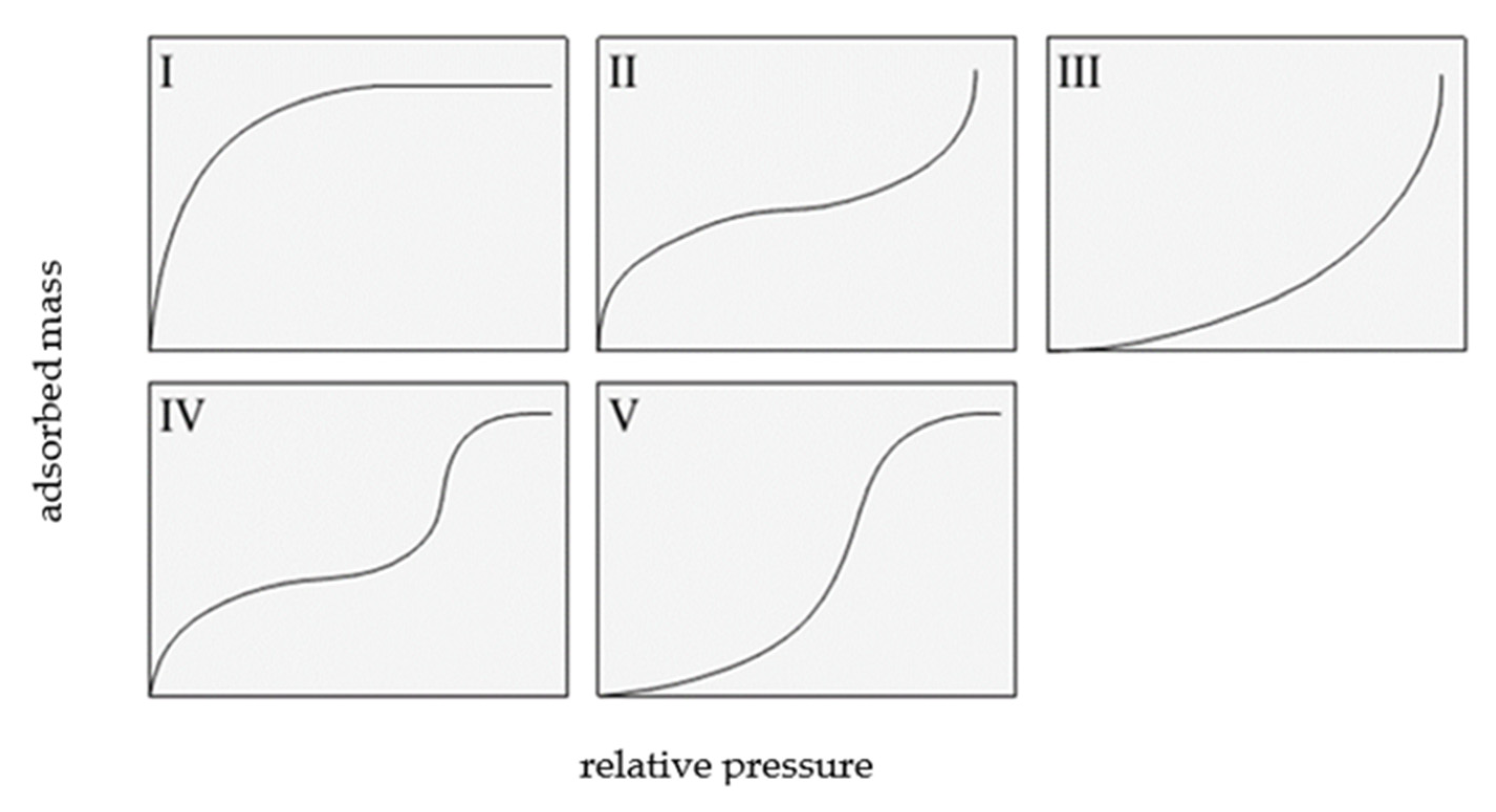
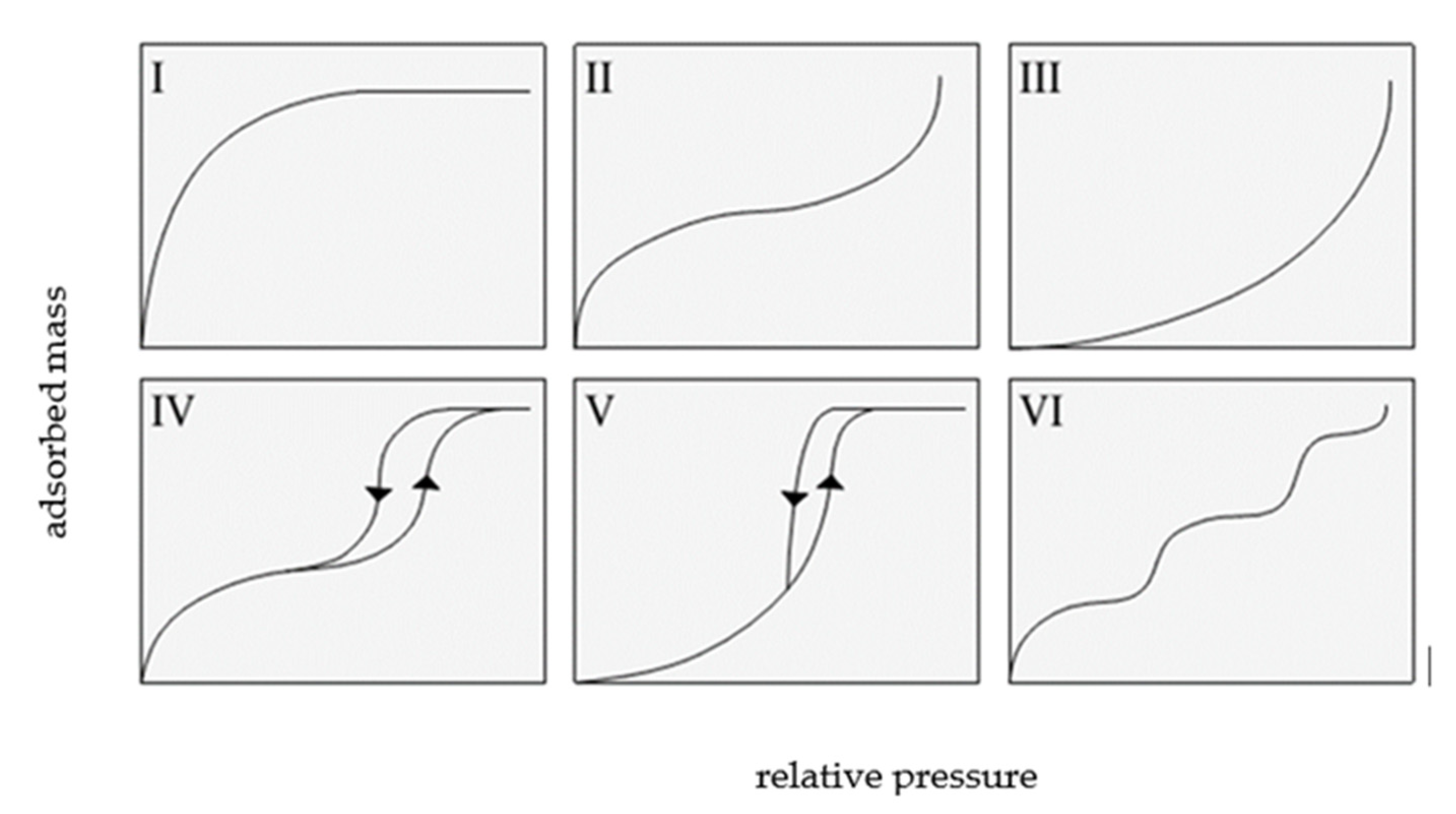
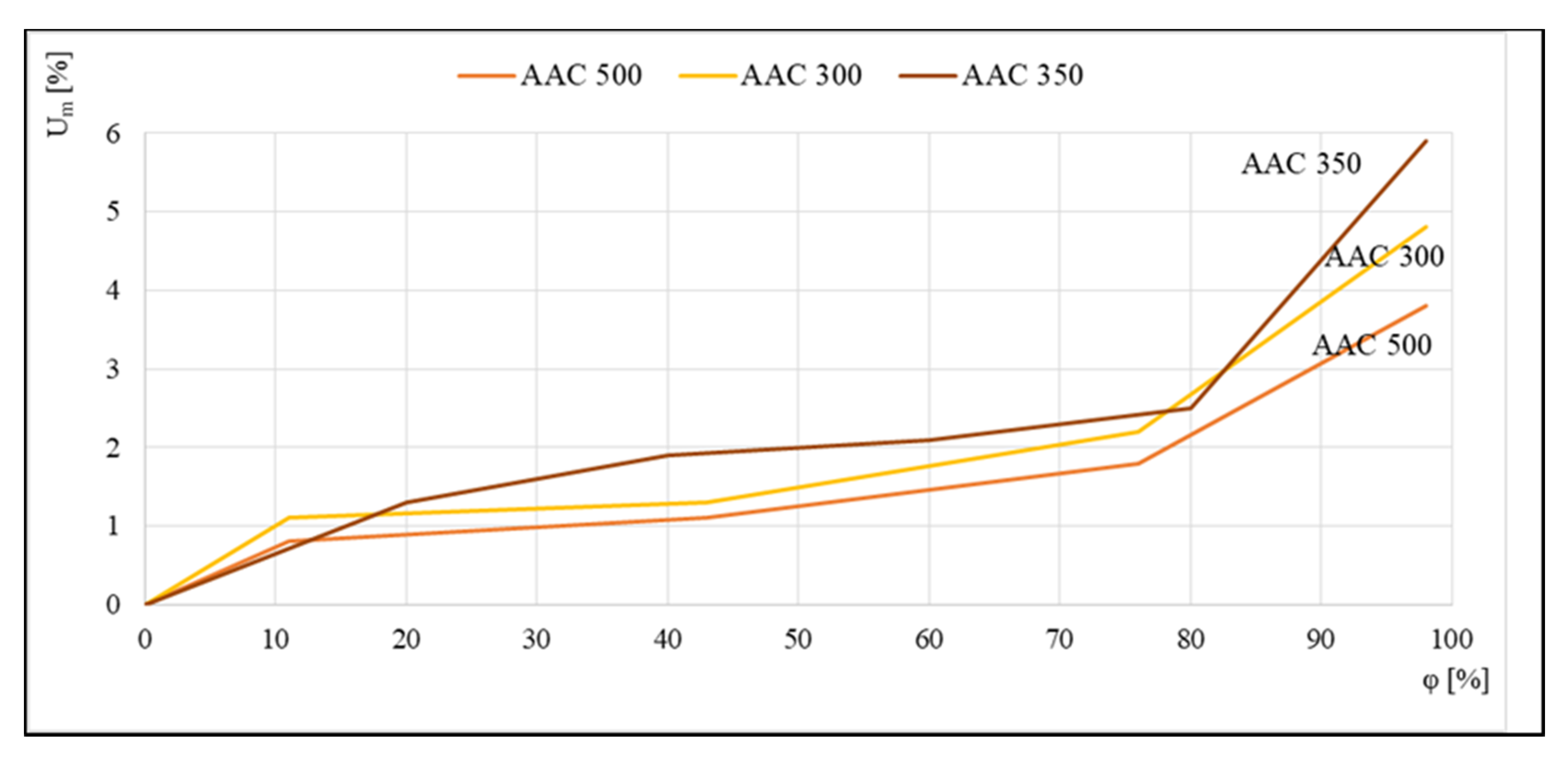
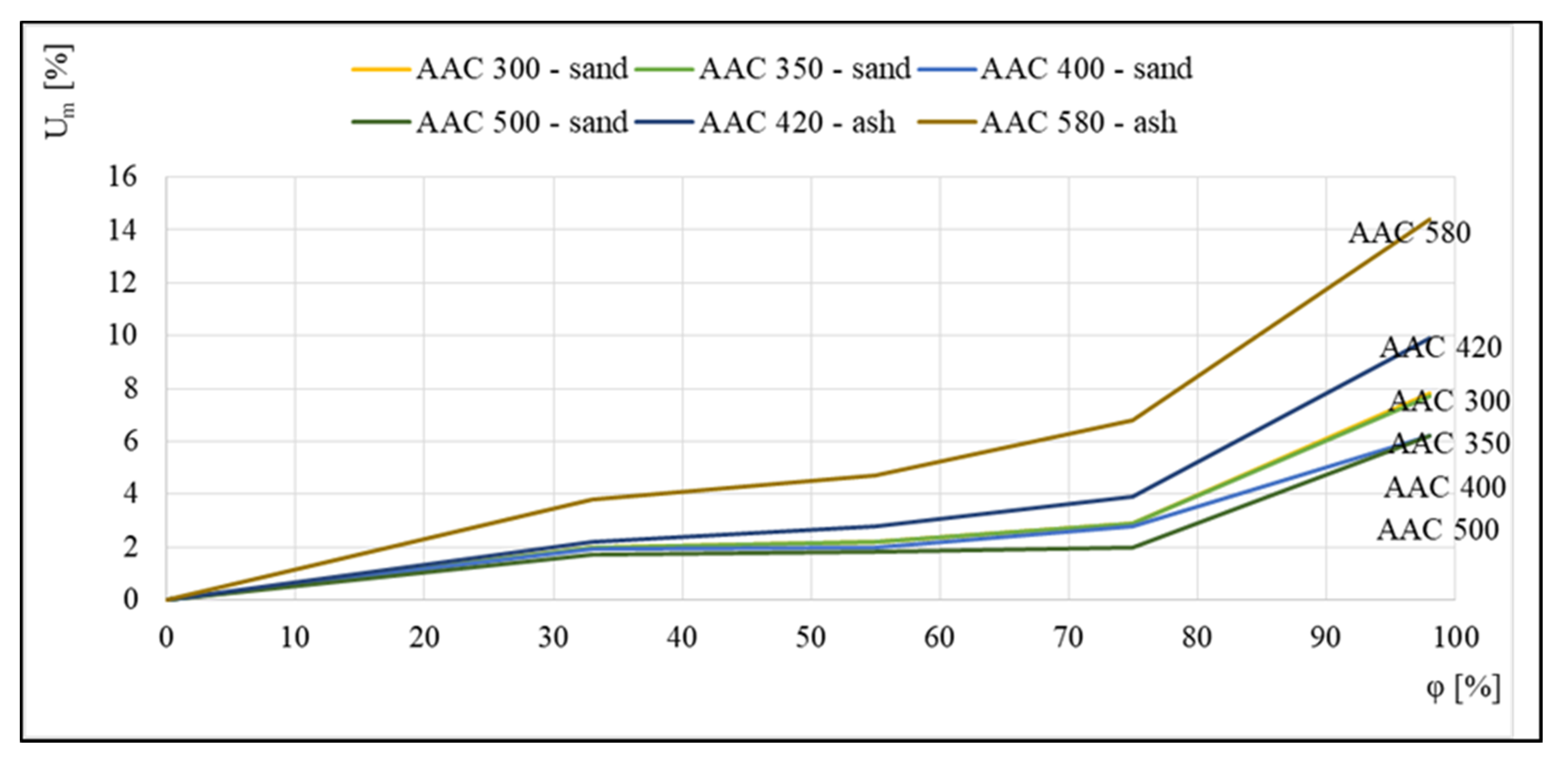

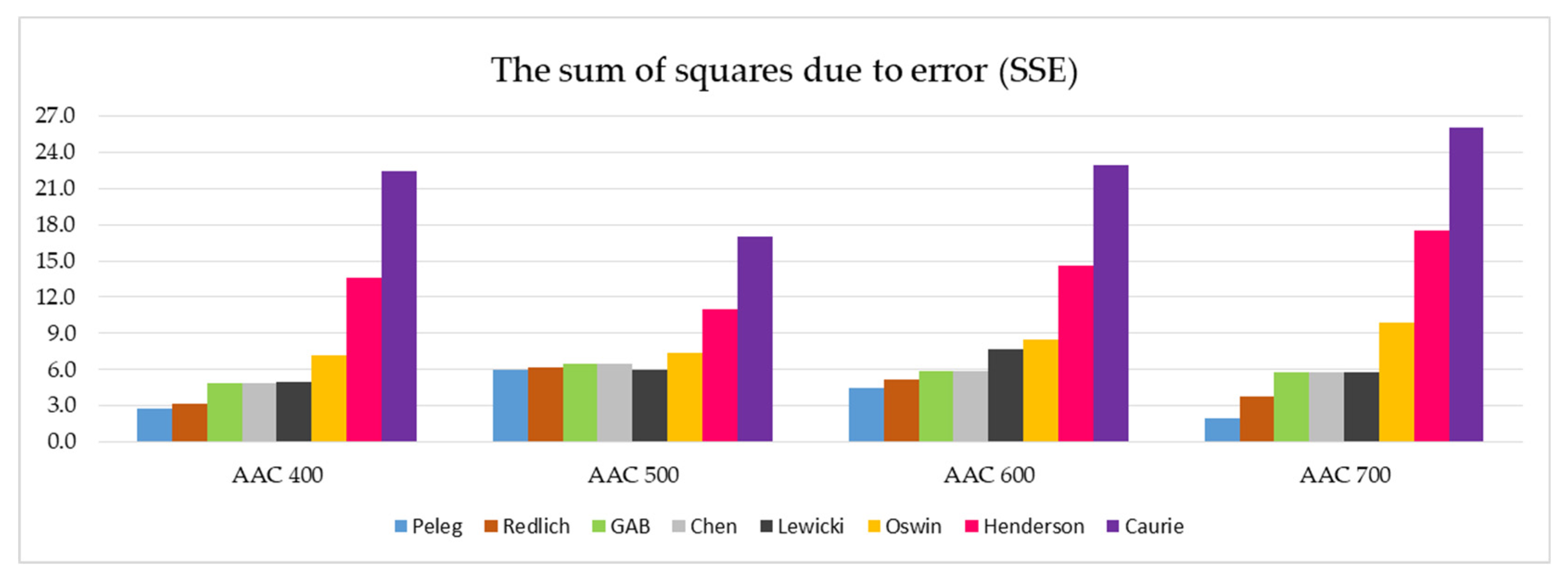

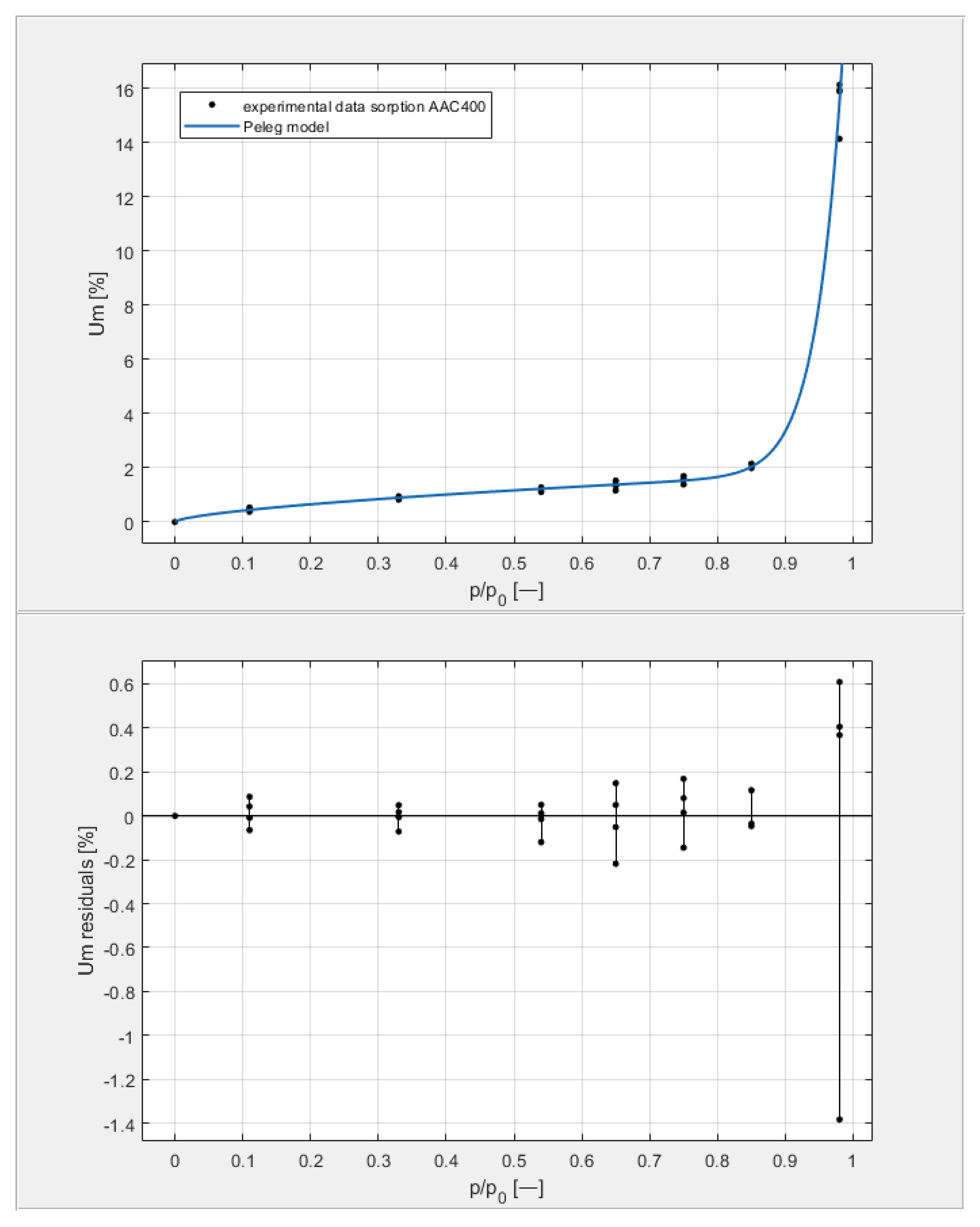
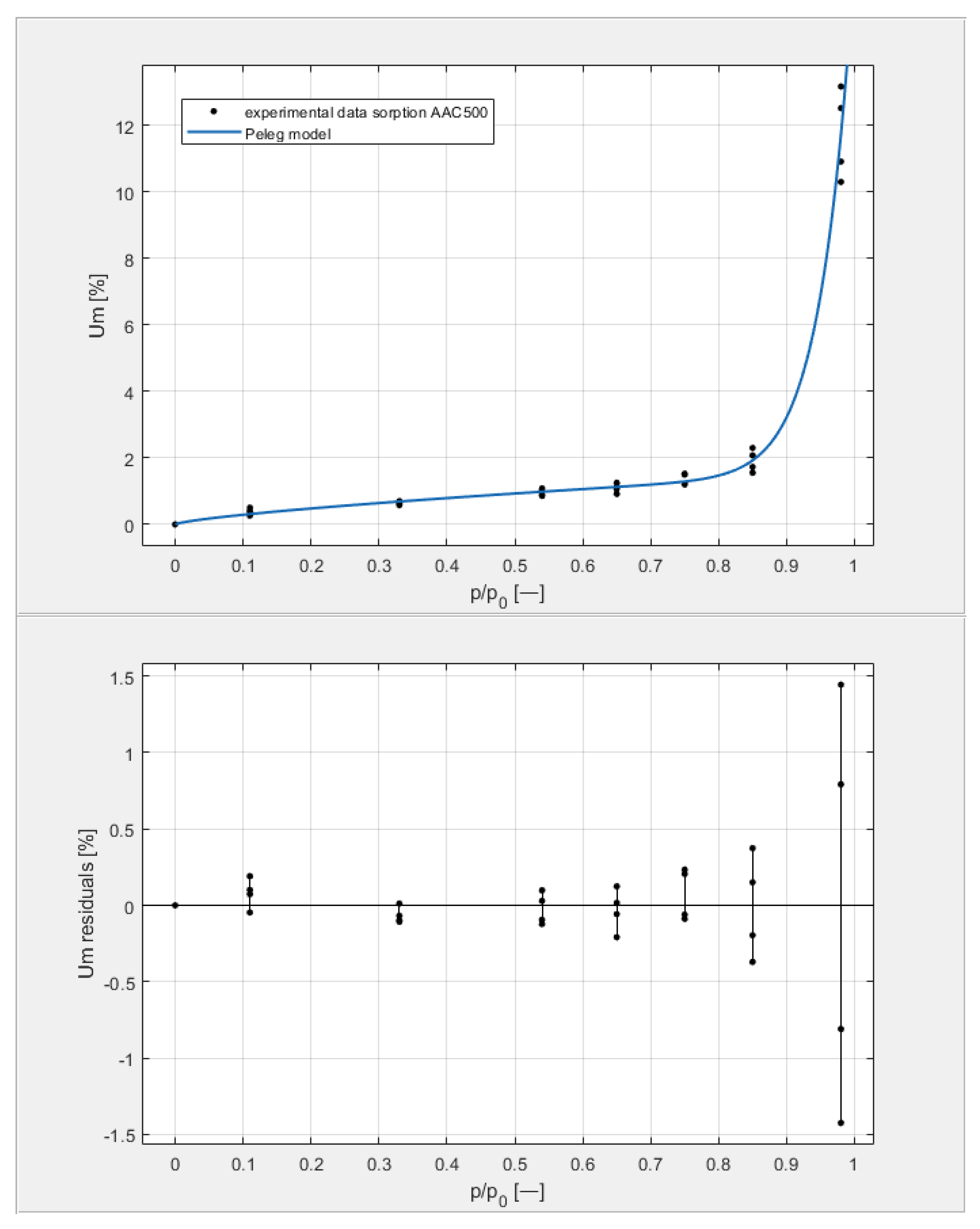


| Mineral | AAC 400 [%] | AAC 500 [%] | AAC 600 [%] | AAC 700 [%] |
|---|---|---|---|---|
| Rutile | 0.04 | 0.02 | 0.05 | 0.06 |
| Basanite | 3.46 | 3.05 | 5.58 | 0.74 |
| Anhydrite | 9.48 | 4.82 | 3.20 | 4.23 |
| Calcite 2 | 4.73 | 5.50 | 2.03 | 1.66 |
| Calcite 1 | 0.73 | 0.47 | 0.18 | 1.50 |
| Tobermorite | 29.02 | 28.35 | 29.99 | 35.42 |
| Quartz | 52.54 | 57.79 | 58.97 | 56.39 |
| Chemical Formula | Name (IUPAC) | T [°C] | φ [%] |
|---|---|---|---|
| LiCl | Lithium chloride | 20 | 11 |
| MgCl2 | Magnesium chloride | 20 | 33 |
| Mg(NO3)2 | Magnesium nitrate (V) | 20 | 54 |
| NaNO2 | Sodium (III) nitrate | 20 | 65 |
| NaCl | Sodium chloride | 20 | 75 |
| KCl | Potassium chloride | 20 | 85 |
| K2SO4 | Potassium sulphate (VI) | 20 | 98 |
| φ [%] | AAC 400 | AAC 500 | AAC 600 | AAC 700 |
|---|---|---|---|---|
| Um [%] | Um [%] | Um [%] | Um [%] | |
| 11 | 0.378 | 0.382 | 0.54 | 0.886 |
| 0.486 | 0.41 | 0.494 | 0.7 | |
| 0.53 | 0.262 | 0.623 | 0.734 | |
| 0.435 | 0.5 | 0.577 | 0.79 | |
| 33 | 0.822 | 0.698 | 0.952 | 1.126 |
| 0.91 | 0.588 | 0.912 | 0.992 | |
| 0.942 | 0.579 | 0.827 | 0.947 | |
| 0.888 | 0.618 | 0.987 | 1.108 | |
| 54 | 1.209 | 1.01 | 1.244 | 1.224 |
| 1.274 | 0.858 | 1.184 | 1.309 | |
| 1.104 | 0.886 | 1.205 | 1.44 | |
| 1.236 | 1.079 | 1.07 | 1.43 | |
| 65 | 1.327 | 1.14 | 1.393 | 1.363 |
| 1.527 | 1.067 | 1.177 | 1.377 | |
| 1.428 | 0.916 | 1.269 | 1.426 | |
| 1.16 | 1.249 | 1.179 | 1.397 | |
| 75 | 1.696 | 1.522 | 1.505 | 1.388 |
| 1.608 | 1.228 | 1.827 | 1.461 | |
| 1.542 | 1.2 | 1.443 | 1.486 | |
| 1.382 | 1.494 | 1.426 | 1.442 | |
| 85 | 2.15 | 1.727 | 2.201 | 1.937 |
| 1.988 | 2.298 | 2.145 | 1.973 | |
| 1.987 | 2.074 | 2.412 | 1.973 | |
| 1.998 | 1.553 | 2.106 | 2.224 | |
| 98 | 15.894 | 13.157 | 14.804 | 17.788 |
| 16.134 | 10.905 | 17.33 | 17.911 | |
| 15.932 | 10.291 | 17.058 | 16.262 | |
| 14.143 | 12.507 | 17.066 | 16.888 |
| Model Parameter | AAC 400 | AAC 500 | AAC 600 | AAC 700 | |
|---|---|---|---|---|---|
| Peleg | k1 | 22.7 | 15.41 | 22.99 | 25.37 |
| k2 | 1.813 | 1.534 | 1.639 | 1.594 | |
| n1 | 24.87 | 20.39 | 21.33 | 23.98 | |
| n2 | 0.6387 | 0.7261 | 0.5099 | 0.3354 | |
| Redlich | K | −1.212 | −1.036 | −1.1 | −1.359 |
| B | 2.183 | 1.738 | 2.114 | 2.265 | |
| n | 16.85 | 9.523 | 11.35 | 22.03 | |
| Chen | a | 1.21 × 104 | 1.54 × 105 | 1.21 × 106 | 1.50 × 106 |
| b | 3.20 × 104 | 4.57 × 105 | 3.13 × 106 | 3.93 × 106 | |
| c | 0.9956 | 0.991 | 0.9965 | 0.9978 | |
| Oswin | a | 0.6346 | 0.5998 | 0.6343 | 0.6084 |
| b | 0.8208 | 0.763 | 0.8377 | 0.8581 | |
| Henderson | a | 0.6135 | 0.6201 | 0.6144 | 0.5539 |
| b | 2.366 | 2.151 | 2.413 | 2.517 | |
| Lewicki | F | 0.4394 | −0.9319 | 5.941 | −11.82 |
| G | 0.9144 | −3.341 | 0.9914 | −0.1096 | |
| H | −6.571 | 4.103 | 1.098 | 31.87 | |
| Caurie | A | 2.93 × 10−5 | 11.76 | 13.56 | 14.5 |
| B | 13.44 | −9.073 | −10.49 | −11.39 | |
| GAB | am | 0.3773 | 0.3375 | 0.388 | 0.3811 |
| c | 3.03 × 106 | 4.75× 105 | 3.27× 106 | 4.16× 106 | |
| K | 0.9956 | 0.991 | 0.9965 | 0.9978 |
| AAC 400 | AAC 500 | AAC 600 | AAC 700 | ||
|---|---|---|---|---|---|
| Peleg | SSE | 2.772 | 6.015 | 4.464 | 1.992 |
| R2 | 0.9963 | 0.9858 | 0.9948 | 0.9978 | |
| RMSE | 0.3146 | 0.4635 | 0.3993 | 0.2667 | |
| Redlich | SSE | 3.124 | 6.13 | 5.158 | 3.791 |
| R2 | 0.9958 | 0.9856 | 0.9935 | 0.9959 | |
| RMSE | 0.3282 | 0.4598 | 0.4218 | 0.3616 | |
| Chen | SSE | 4.883 | 6.518 | 5.895 | 5.781 |
| R2 | 0.9934 | 0.9847 | 0.9931 | 0.9937 | |
| RMSE | 0.4104 | 0.4741 | 0.4509 | 0.4465 | |
| Oswin | SSE | 7.155 | 7.377 | 8.465 | 9.884 |
| R2 | 0.9901 | 0.9826 | 0.9901 | 0.9892 | |
| RMSE | 0.4884 | 0.4959 | 0.5312 | 0.574 | |
| Henderson | SSE | 13.64 | 11.01 | 14.59 | 17.47 |
| R2 | 0.9817 | 0.9741 | 0.9829 | 0.9809 | |
| RMSE | 0.6742 | 0.6057 | 0.6974 | 0.7632 | |
| Lewicki | SSE | 4.933 | 6.003 | 7.719 | 5.796 |
| R2 | 0.9934 | 0.9859 | 0.991 | 0.9937 | |
| RMSE | 0.4124 | 0.455 | 0.5159 | 0.4471 | |
| Caurie | SSE | 22.41 | 17.03 | 22.94 | 26.06 |
| R2 | 0.9699 | 0.9599 | 0.9731 | 0.9715 | |
| RMSE | 0.8644 | 0.7533 | 0.8744 | 0.932 | |
| GAB | SSE | 4.883 | 6.518 | 5.895 | 5.781 |
| R2 | 0.9934 | 0.9847 | 0.9931 | 0.9937 | |
| RMSE | 0.4104 | 0.4741 | 0.4509 | 0.4465 |
Publisher’s Note: MDPI stays neutral with regard to jurisdictional claims in published maps and institutional affiliations. |
© 2021 by the authors. Licensee MDPI, Basel, Switzerland. This article is an open access article distributed under the terms and conditions of the Creative Commons Attribution (CC BY) license (https://creativecommons.org/licenses/by/4.0/).
Share and Cite
Garbalińska, H.; Bochenek, M.; Stasiak, M. Experimental and Modeling Investigations on the Water Sorption Behaviors of Autoclaved Aerated Concrete. Materials 2021, 14, 6235. https://doi.org/10.3390/ma14216235
Garbalińska H, Bochenek M, Stasiak M. Experimental and Modeling Investigations on the Water Sorption Behaviors of Autoclaved Aerated Concrete. Materials. 2021; 14(21):6235. https://doi.org/10.3390/ma14216235
Chicago/Turabian StyleGarbalińska, Halina, Magdalena Bochenek, and Marcin Stasiak. 2021. "Experimental and Modeling Investigations on the Water Sorption Behaviors of Autoclaved Aerated Concrete" Materials 14, no. 21: 6235. https://doi.org/10.3390/ma14216235
APA StyleGarbalińska, H., Bochenek, M., & Stasiak, M. (2021). Experimental and Modeling Investigations on the Water Sorption Behaviors of Autoclaved Aerated Concrete. Materials, 14(21), 6235. https://doi.org/10.3390/ma14216235







